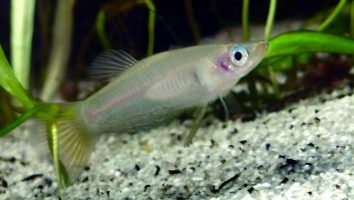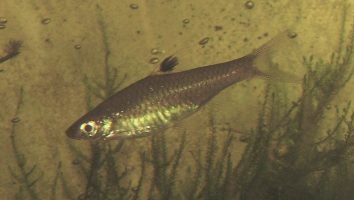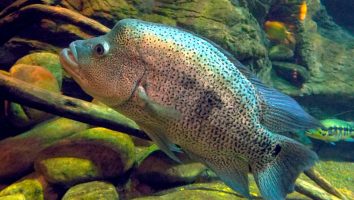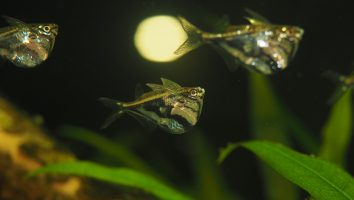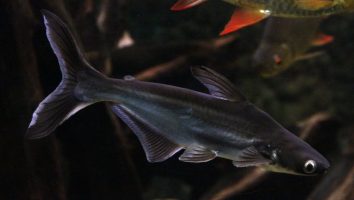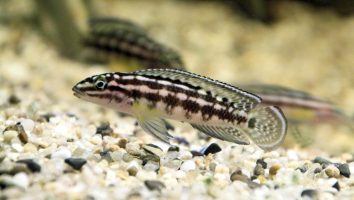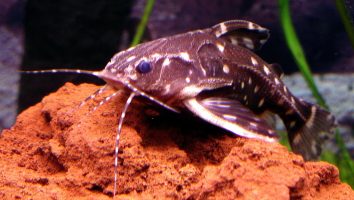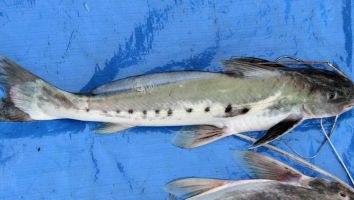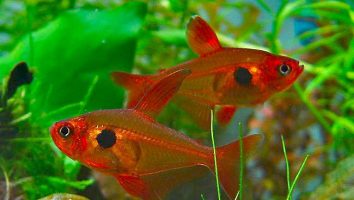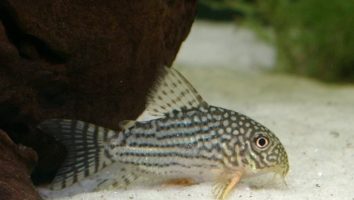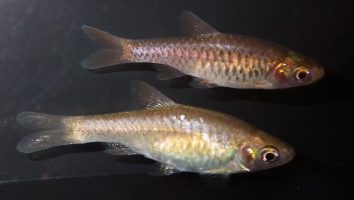The walking catfish is a freshwater fish that gets its name from its ability to “walk” on land.
This fish is native to Southeast Asia but has been introduced to other parts of the world, including the United States.
The walking catfish is a hardy fish that can live in a variety of conditions, which makes it a popular choice for aquariums.
This guide will teach you everything you need to know about walking catfish care. You’ll learn about their diet, size, lifespan, and more!
Table of contents
Species overview
The walking catfish (Clarias batrachus) is a type of air-breathing catfish that’s native to Southeast Asia. It gets its name from its ability to “walk” on land using its pectoral fins.
These fish are most commonly found in Thailand, Malaysia, Indonesia, and Vietnam. However, they have also been introduced to various other parts of the world, such as the United States, where they are considered to be an invasive species.
Walking catfish are relatively large compared to other types of catfish. They can grow to be up to 40 cm (16 inches) in length and weigh up to 4 kg (9 pounds).
Despite their size, these fish are fairly peaceful and can be kept with other fish that are similar in size and temperament. They are also a popular choice for aquariums because they are relatively easy to care for.
Appearance
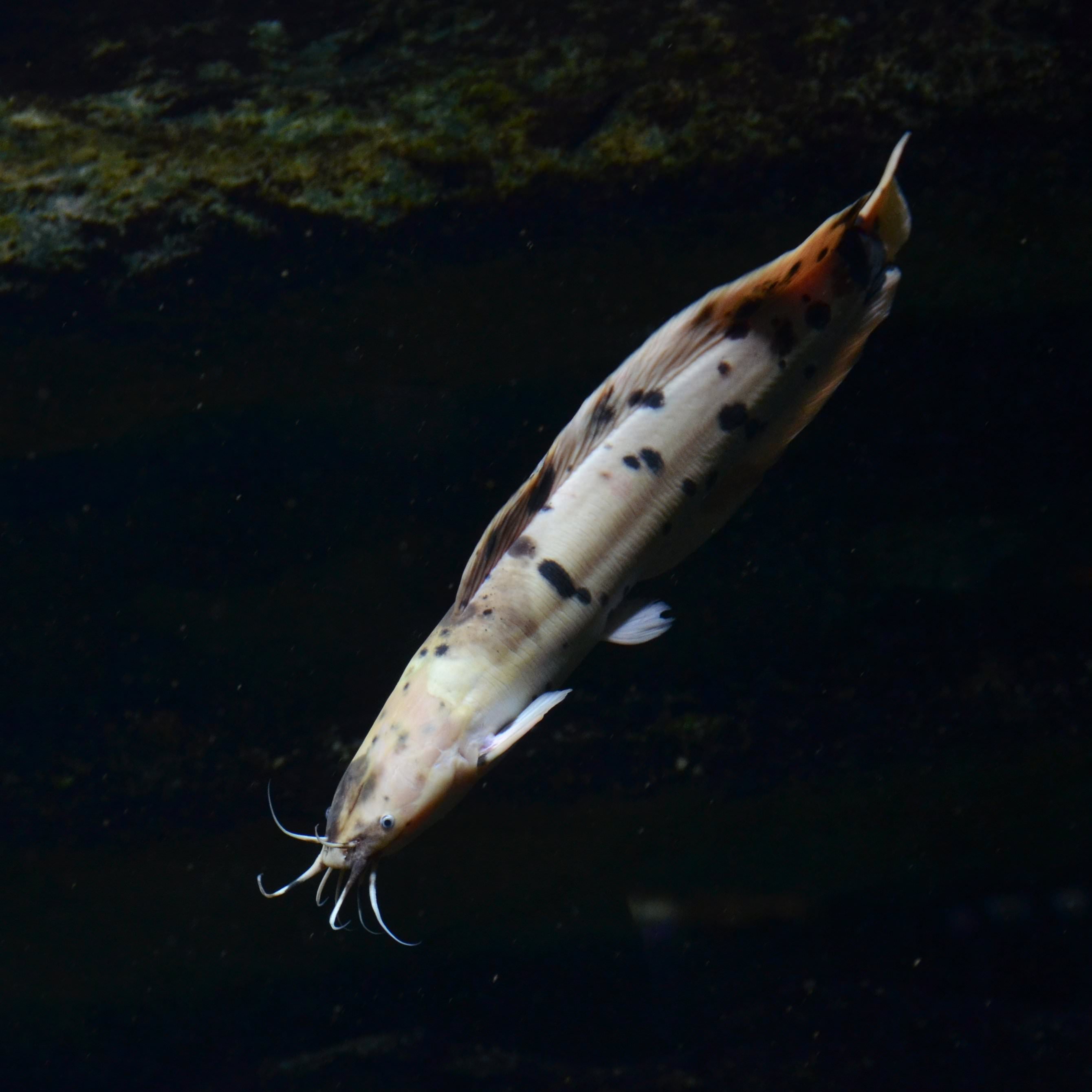
The first thing you’ll notice about this fish is their unique form of locomotion. As their name suggests, these fish “walk” across land using their fins. They have a set of modified pectoral fins that help them “crawl” from one place to another.
While this fish is capable of swimming, they prefer to “walk” around their environment.
This fish has a long and thin body that tapers down at the end. They have a set of small barbels around their mouths that they use to help find food.
The dorsal fin on this fish is rather long and starts about two-thirds of the way back on their body. The anal fin is similar in size and placement.
Walking catfish have a forked caudal fin that’s taller than it is wide.
The body of this fish is covered in small scales that have a rough texture. The coloration of this fish can vary quite a bit. They can be brown, grey, or even greenish in color.
There are also some walking catfish that have a mottled pattern on their body.
Lifespan
The average lifespan of a walking catfish is around 10 years. However, there are a number of factors that can impact their life expectancy.
One of the biggest is the environment they’re kept in. Poor water quality can shorten their lifespan significantly.
Another factor is their diet. Walking catfish are omnivores, so they need a diet that includes both plant and animal matter. If they’re not getting enough of either, it can lead to health problems that shorten their lifespan.
Size
The average size of a fully grown walking catfish is about 18 inches long, but they can grow to be up to 24 inches in some cases. These fish are also pretty wide, so they need a tank that can accommodate their size.
Tank
Tank Size
The recommended tank size for a Walking Catfish is 20 gallons. If you’re looking for a smaller freshwater fish, the Walking Catfish is a great choice.
While 20 gallons is the minimum, we recommend going a bit larger if you can. These fish are known to be escape artists and will find their way out of the tank if they can.
Another reason to provide a little extra space is that Walking Catfish are known to be a bit aggressive. If you want to keep them with other fish, you’ll need to make sure there’s enough space for everyone to coexist peacefully.
Water Parameters
The walking catfish is a freshwater species that is most commonly found in Southeast Asia.
One of the reasons they’re so popular is that they can tolerate a wide range of water parameters. This includes everything from brackish to fully freshwater tanks.
The only thing you need to be careful about is making sudden changes. These fish are pretty hardy, but they can still be sensitive to sudden shifts in their environment.
Here are some basic water parameters to help you create a healthy environment for your walking catfish.
- Water temperature: 72 to 86 degrees Fahrenheit
- pH levels: 6.5 to 7.5
- Water hardness: 2 to 12 dGH
- Alkalinity Levels: 4-8 dKH
What To Put In Their Tank
When it comes to setting up the inside of an aquarium for walking catfish, there are a few key things to keep in mind.
First and foremost, these fish are escape artists. They have been known to squeeze through the tiniest of openings so it’s important to have a well-sealed tank.
We recommend using a glass aquarium with a tightly fitting lid. If you have any gaps, make sure to seal them with silicone.
Another thing to consider is the substrate. Walking catfish have a tendency to eat just about anything, and that includes gravel.
To avoid any issues, we recommend using a sand substrate instead. This will also make it easier for them to burrow (which they love to do).
As for decorations, it’s really up to you. These fish aren’t too picky when it comes to that sort of thing. You can add rocks, driftwood, plants, or anything else you want. Just make sure there aren’t any sharp edges that could hurt them.
Common Diseases
The walking catfish is a pretty hardy fish, but that doesn’t mean they can’t get sick. There are a few diseases that these fish are susceptible to, the most common being ich.
Ich is a very common parasite that can become quite serious if it’s not dealt with. The most obvious sign of this disease is the series of white spots that will begin to cover the body of your fish.
There are plenty of other potential diseases that can affect this species as well, but they’re not as common.
Another thing to look out for is infection from cuts. The most common cause of this is keeping your walking catfish in a tank with a rough substrate (or aggressive species that want to fight).
In general, the best way to prevent these fish from getting sick is to maintain the quality of the water in their tank. A tank with clean and stable water conditions always leads to healthier fish who are more resistant to disease.
Behavior & Temperament
Walking catfish are nocturnal animals, so don’t expect to see them much during the day. They’ll be hiding in the shadows, waiting for the sun to go down so they can start foraging for food.
Walking catfish are peaceful fish, but they can be a bit aggressive when it comes to food. They’re known to be quite greedy, so make sure you’re feeding them enough. They’ll also compete with other bottom-dwelling fish for food, so keep an eye on them at feeding time.
These fish get their name from their ability to “walk” across dry land. They have a special adaptation that allows them to breathe air, so they can survive outside of water for a period of time.
While this may seem like a cool party trick, it can actually be quite dangerous for your fish. If they manage to escape your tank, they could end up anywhere. It’s best to keep a close eye on them and make sure their tank is secure.
Tank Mates
The walking catfish is a species that does best when kept with its own kind. This is largely due to the fact that they’re such social animals.
While they can certainly be kept with other species, it’s often better to stick to their own. If you do want to try a community tank, these are some compatible walking catfish tank mates:
- Other Walking Catfish
- Plecostomus
- Synodontis
- Bichir
- Clown Loach
- Rope Fish
Breeding
Walking catfish are easy to breed in captivity and will often do so without any help from the keeper. If you want to increase the chances of breeding, though, there are a few things you can do.
The first step is to set up a breeding tank. It should be at least 20 gallons in size and can be either freshwater or brackish. The water should be warm, around 80 degrees Fahrenheit.
Then, add some plants and hiding places. This species likes to lay its eggs on plants, so the more plants you have, the better.
You should also add a few pieces of driftwood. Driftwood helps to lower the pH of the water, which is something these fish need for breeding.
When the tank is set up, add two females for every male. These fish are polygamous breeders, so the female will lay eggs and the male will fertilize them.
It’s not uncommon for a female to lay up to 1000 eggs at a time!
The eggs will hatch in about 24 hours. The fry are very small and need to be fed baby brine shrimp or other live foods.
Once they’re a bit bigger, you can start feeding them flakes or pellets.
Conclusion
The Walking Catfish is a freshwater fish that is native to Southeast Asia.
They get their name from their ability to “walk” on land for short distances.
This fish is a member of the family of fishes called the Siluriformes.
The Walking Catfish is a nocturnal fish and is therefore most active at night.
This fish has a long, slender body and can grow up to 18 inches in length.
The Walking Catfish is a popular fish in the aquarium trade.
While they are not the most attractive fish, their curious nature and ability to “walk” make them a popular choice for many aquarium owners.
The Walking Catfish is an easy fish to care for and is a good choice for beginner aquarium owners.

